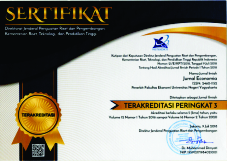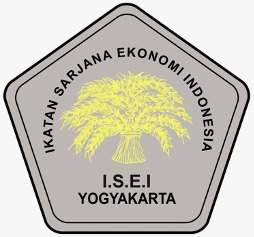Foreign Direct Investment and Youth Employment Causality: Evidence From ASEAN-5 Countries
Downloads
Keywords: Foreign Direct Investment, Youth Employment, Granger Causality, ASEAN-5
Kausalitas Penanaman Modal Asing dan Penyerapan Tenaga Kerja Muda: Bukti dari Negara-negara ASEAN-5
Abstrak: Keterkaitan antara FDI dan penyerapan tenaga kerja telah menjadi perhatian utama banyak peneliti karena temuan yang beragam. FDI dinyatakan dapat memicu pertumbuhan lapangan kerja, namun di sisi lain, beberapa peneliti menemukan bahwa kondisi ketenagakerjaanlah yang mempengaruhi arus masuk FDI. Sementara itu, beberapa penelitian lain menemukan adanya hubungan dua arah, atau bahkan tidak ada hubungan. Dengan fokus pada penyerapan tenaga kerja muda, penelitian ini bertujuan untuk mengkaji hubungan antara FDI dan penyerapan tenaga kerja muda di negara-negara ASEAN-5. Dari hasil uji kausalitas Granger ditemukan bahwa di Indonesia, Malaysia, Filipina, dan Singapura, aliran FDI yang masuk mengarah pada pada penciptaan lapangan kerja bagi kaum muda, sedangkan di Thailand ditemukan hubungan yang sebaliknya. Secara keseluruhan, tidak ditemukan hubungan kausal dua arah antara FDI dan penyerapan tenaga kerja muda di negara-negara ASEAN-5.
Kata kunci: Penanaman Modal Asing, Penyerapan Tenaga Kerja Muda, Kausalitas Granger, ASEAN-5
Downloads
Adam P. B., Żurek, M., (2011), Foreign Direct Investment and Unemployment: VAR Analysis for Poland in the Years 1995-2009, European Research Studies, Volume XIV, Issue (1).
Bakkalcı, A. C. and N. Argın (2013), Internalization of Foreign Trade in the Context of Labour Market Induced by Foreign Investment, Journal of Labour Relations, Vol. 4, Number 1, pp. 71-97.
Ebaidalla, E. M. (2014, November). Effect of ICTs on youth unemployment in Sub Saharan Africa: A panel data analysis. In A paper prepared for African Economic Conference on "Knowledge and Innovation for Africa's Transformation", Abidjan, Cote d'Ivoire, 1st-3rd.
Erdal, F., & Tatoglu, E. (2002). Locational determinants of foreign direct investment in an emerging market economy: evidence from Tukey. Multinational business review, 10, 21-27.
Ernst, Crhistoph. (2005). The FDI – employment link in a globalizing world: The case of Argentina, Brazil and Mexico. Employment Analysis Unit Employment Strategy Department. ILO.
Goel, N. (2020). Repercussion of FDI on employment generation in Indian retail: a statistical analysis. International Journal of Business and Globalisation, 25(4), 405-418.
Hasan, Zainul. and Sasana, Hadi. (2020). Determinants Of Youth Unemployment Rate In ASEAN. International Journal Of Scientific & Technology Research Vol. 9 (3). pp 6687-6691.
Hirschmann, R. (2020). Youth unemployment rate in Singapore 2011-2020. Retrieved from https://www.statista.com/statistics/708329/singapore-youth-unemployment-rate/ at December 10th, 2020.
ILO (2011). Global Employment Trends for Youth, Geneva: International Labour Organisation.
ILO. (2017). Youth Employment Policy Summary Singapore. Geneva: International Labour Organisation.
ILO. (2020), Global Employment Trends for Youth 2020: Technology and the Future of Jobs. Geneva: International Labour Organisation.
Irpan, H. M., Saad, R. M., Nor, A. H. S. M., Noor, A. H. M., & Ibrahim, N. (2016). Impact of foreign direct investment on the unemployment rate in Malaysia. In Journal of Physics: Conference Series (Vol. 710, No. 1, p. 012028).
Jibir, A., & Abdu, M. (2017, January). Foreign Direct Investment – Growth Nexus:
The Case of Nigeria. European Scientific Journal, 13(1), 304-318.
Karim, B. A., Karim, Z. A., & Nasharuddin, M. N. (2019). Corruption and Foreign Direct Investment (FDI) in ASEAN-5: A panel evidence. Economics and Finance in Indonesia, 64(2), 145-156.
Karlsson, S., Lundin, N., Sjí¶holm, F., & He, P. (2007). FDI and job creation in China (No. 723). IFN Working Paper.
Lipsey, Robert E. (2006), Measuring the Impacts of FDI in Central and Eastern Europe. National Bureau of Economic Research Working Paper No. 12808.
Mkombe, D., Tufa, A. H., Alene, A. D., Manda, J., Feleke, S., Abdoulaye, T., & Manyong, V. (2020). The effects of foreign direct investment on youth unemployment in the Southern African Development Community. Development Southern Africa, 1-16.
Msigwa, R., & Kipesha, E. F. (2013). Determinants of youth unemployment in developing countries: Evidences from Tanzania. Journal of Economics and Sustainable Development Vol.4, No.14, 2013.
O'Higgins, N. (2010) The Impact of the Economic and Financial Crisis on Youth Employment: Measures for Labour Market Recovery in the European Union, Canada and the United States., ILO Working Papers.
Parcon, H. (2008). Labor market flexibility as a determinant of FDI inflows. University of Hawaii at Manoa, Department of Economics, Working Papers, 08-07.
Patel, Dipali Pravin Chhaganlal & Choga, Ireen. (2018). Determinants Of Youth Unemployment In South Africa. 9th Economics & Finance Conference, London 22 May 2018.
Pieters, Janneke. (2013). Youth Employment in Developing Countries. IZA Research Report No. 58, issue October 2013.
Strat, V. A., Davidescu, A., & Paul, A. M. (2015). FDI and the unemployment-a causality analysis for the latest EU members. Procedia economics and finance, 23(2015), 635-643.
Thailand Board of Investment. (2020). Thailand in Brief. Retrieved from https://www.boi.go.th/index.php?page=demographic at December 10th, 2020.
Tsaurai, K. (2018). Exploring the employment effect of FDI in BRICS: Does conditionalities matter?. Acta Universitatis Danubius. Å’conomica, 14(3), 86-103.
United States Government a. (2020). 2020 Investment Climate Statements: Philippines. Retrieved from https://www.state.gov/reports/2020-investment-climate-statements/philippines/ on December 9th, 2020.
United States Government b. (2020). 2020 Investment Climate Statements: Singapore. Retrieved from https://www.state.gov/reports/2020-investment-climate-statements/singapore/on December 9th, 2020.
Xaypanya, P, Rangkakulnuwat, P, & Paweenawat, SW 2015, The determinants of foreign direct investment in ASEAN: The first differencing panel data analysis. International Journal of Social Economics, 42(3), pp.239-250
Yayli, S. and M. K. Değer (2012), The Relationships Between Foreign Direct Investments and Employment: Dynamic Panel Data Causality Analysis on Developing Countries (1991-2008), Finans, Politik ve Ekonomik Yorumlar, 49 (568), pp. 43-51.















